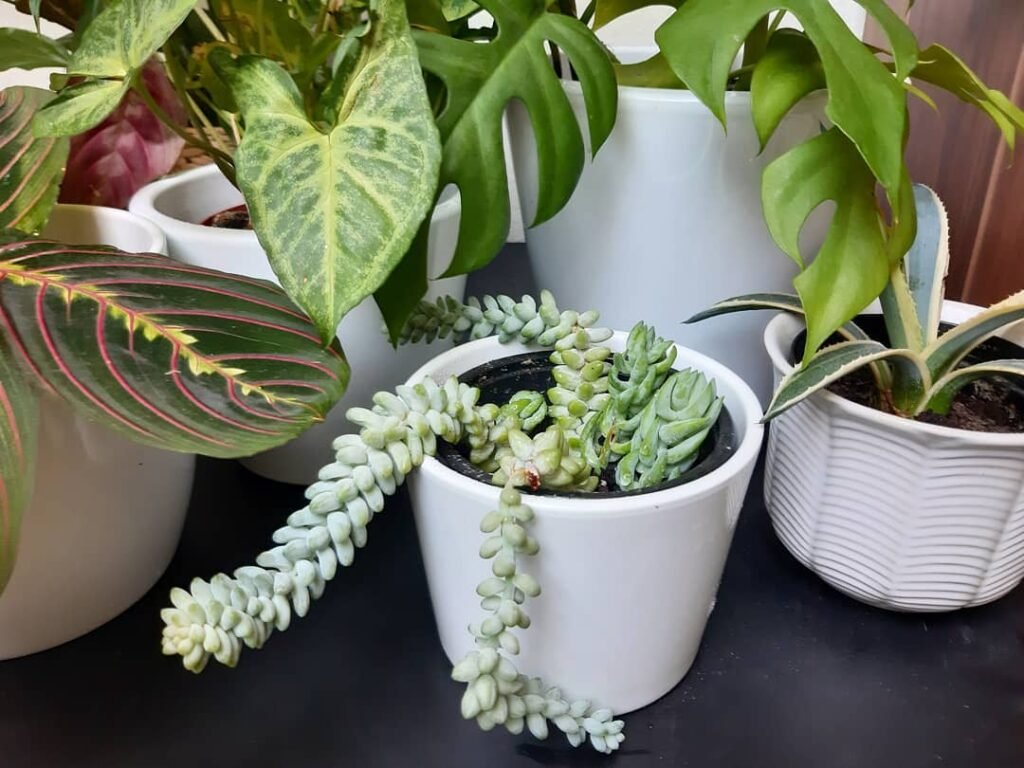Are you looking to add a touch of greenery to your indoor space, but aren’t sure where to begin? Look no further than Sedum Morganianum, commonly known as Burro’s Tail. This stunning succulent plant with cascading stems and plump, blue-green leaves is the perfect addition to any indoor garden. But how do you care for this unique and beautiful plant in the UK climate?
In this article, I will share with you some essential care tips to ensure your Sedum Morganianum thrives and remains healthy and beautiful. From understanding its appearance to knowing its light requirements and watering needs, I’ve got you covered. So, let’s dive in and discover how to care for Sedum Morganianum!
Appearance of Sedum Morganianum (Burro’s Tail)

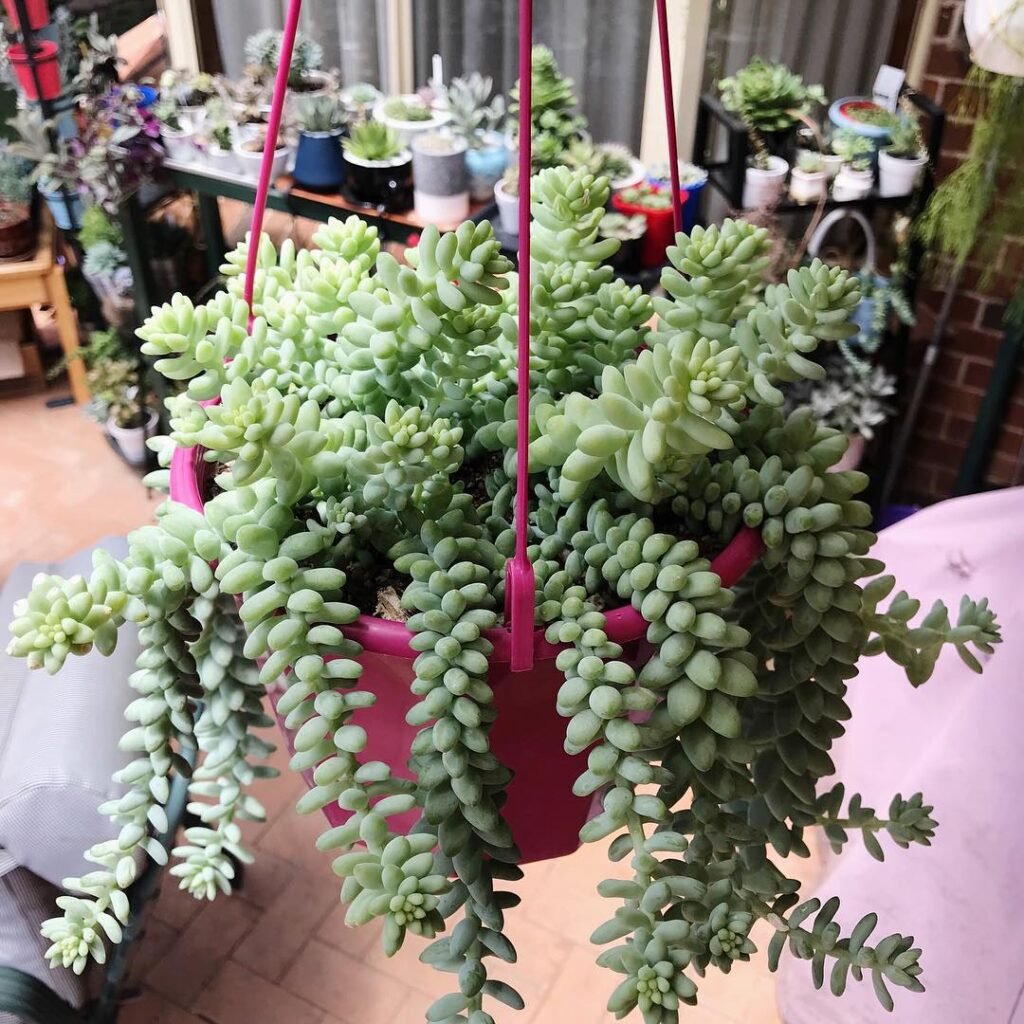
Sedum Morganianum, also known as Burro’s Tail or donkey tail plant, is a stunning succulent that will add a touch of elegance to any indoor space. This beautiful plant features long, trailing stems that can grow up to an impressive 60 cm in length. The stems are adorned with overlapping, plump leaves that have a striking blue-green hue.
The unique arrangement of the leaves gives Sedum Morganianum its distinctive donkey tail-like appearance, making it a real eye-catcher. Whether draping over the edge of a hanging basket or trailing down a shelf, this succulent is sure to captivate with its cascading beauty.
 Sedum Morganianum can grow dramatic trails up to 60cm long! Even more fascinating, it occasionally surprises with rare, vivid pink and red flowers. This combo of lush green drapes and unexpected blooms makes it an unforgettable spectacle in any plant collection.
Sedum Morganianum can grow dramatic trails up to 60cm long! Even more fascinating, it occasionally surprises with rare, vivid pink and red flowers. This combo of lush green drapes and unexpected blooms makes it an unforgettable spectacle in any plant collection.
Light Requirements for Sedum Morganianum


Sedum Morganianum, also known as the Burro’s Tail or Donkey Plant, is a beautiful succulent that flourishes with just the right light. For optimal growth and health:
- It loves basking in bright, indirect sunlight.
- It enjoys a bit of morning or late afternoon sun.
- In winter, it’s important to catch a few hours of mild sunlight to prevent root rot while avoiding harsh direct rays that could damage the leaves.
As daylight dims in winter, placing your Burro’s Tail in the lightest spot available will ensure it gets the light it needs. Just steer clear of strong direct sun during the peak hours to keep its lovely leaves safe.

Watering Tips for Sedum Morganianum (Burro’s Tail)
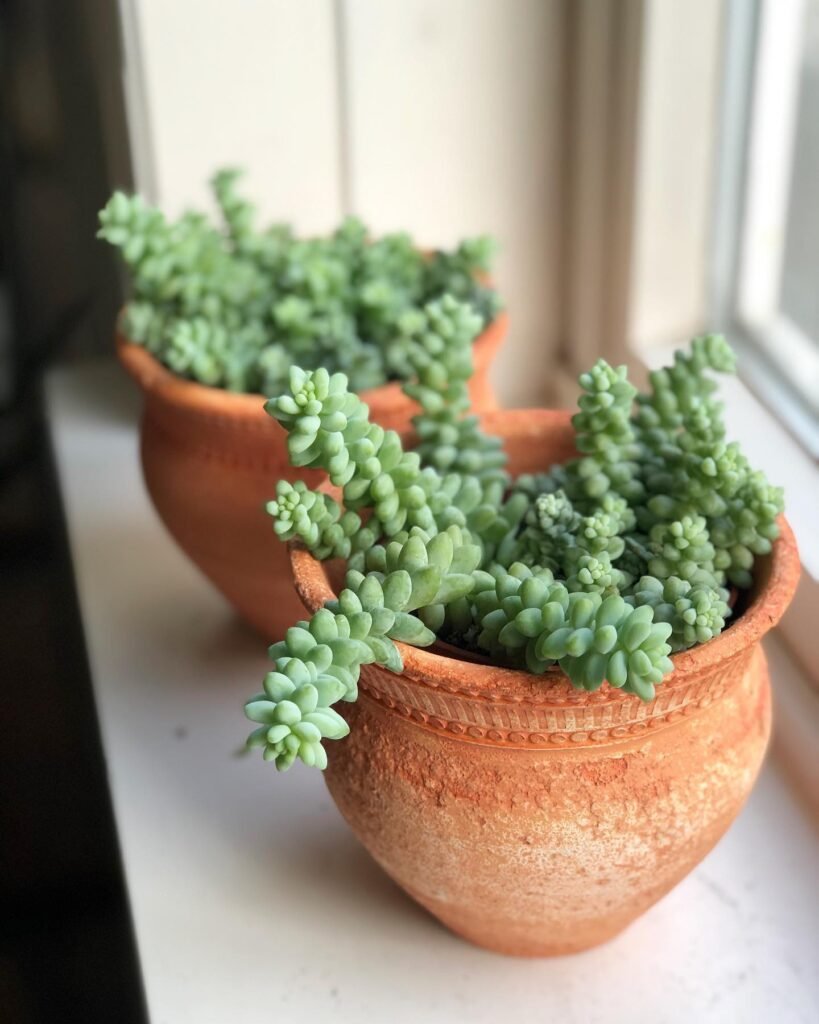
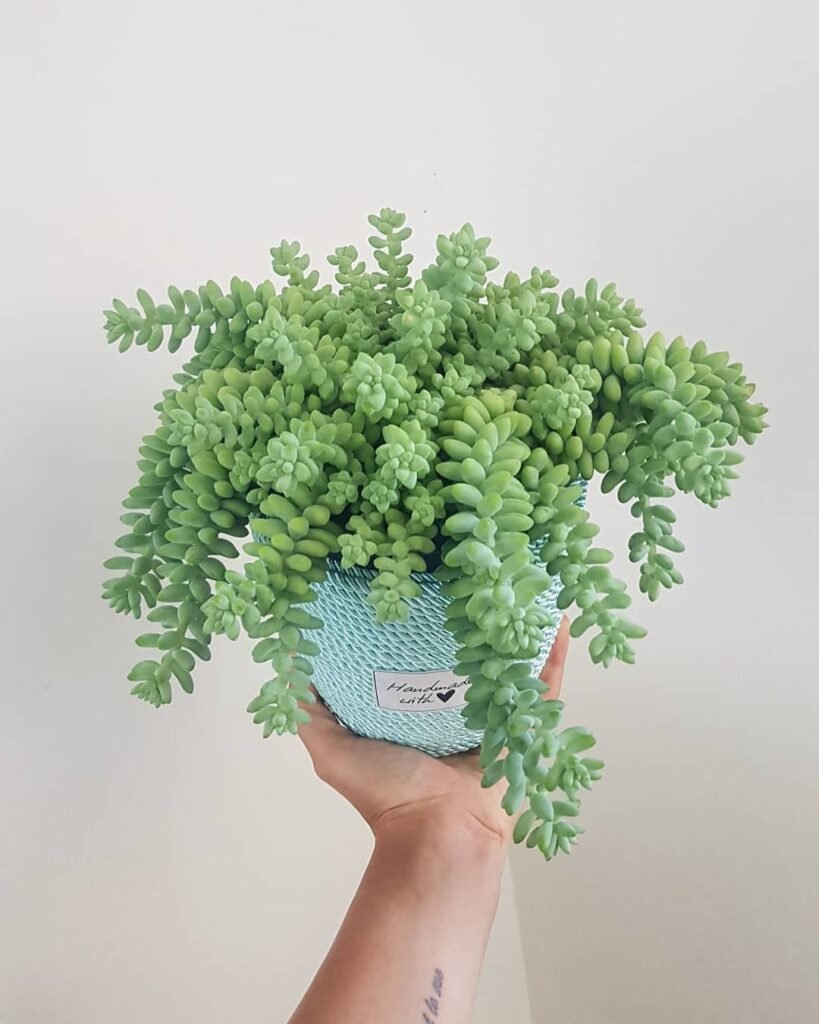
When it comes to caring for your Sedum Morganianum, proper watering is crucial. Overwatering can result in root rot and other issues, so it’s important to follow these watering tips to keep your plant healthy and thriving.
1. Allow the soil to dry out completely between waterings: Sedum Morganianum is a succulent plant that is adapted to arid conditions. It thrives in well-draining soil, so make sure the top inch or two of the soil is dry before watering again. This usually means watering your plant every 2-3 weeks, but it may vary depending on the climate and humidity levels in your home.
2. Use the “Drenches Between Droughts” method: This watering technique involves thoroughly soaking the soil when you do water. Pour water onto the soil until it starts to drain out of the bottom of the pot. This ensures that the roots receive a good drink while also promoting proper drainage. After watering, allow the soil to dry out completely before watering again.
3. Water using the bottom-up method: To prevent rotting foliage, it’s best to water your Sedum Morganianum from the bottom. Fill a tray or saucer with water and place the pot on top, allowing the plant to absorb water through the drainage holes at its own pace. Once the soil is evenly moist, remove any excess water from the tray to avoid waterlogged roots.

Fertilizing and Soil for Sedum Morganianum
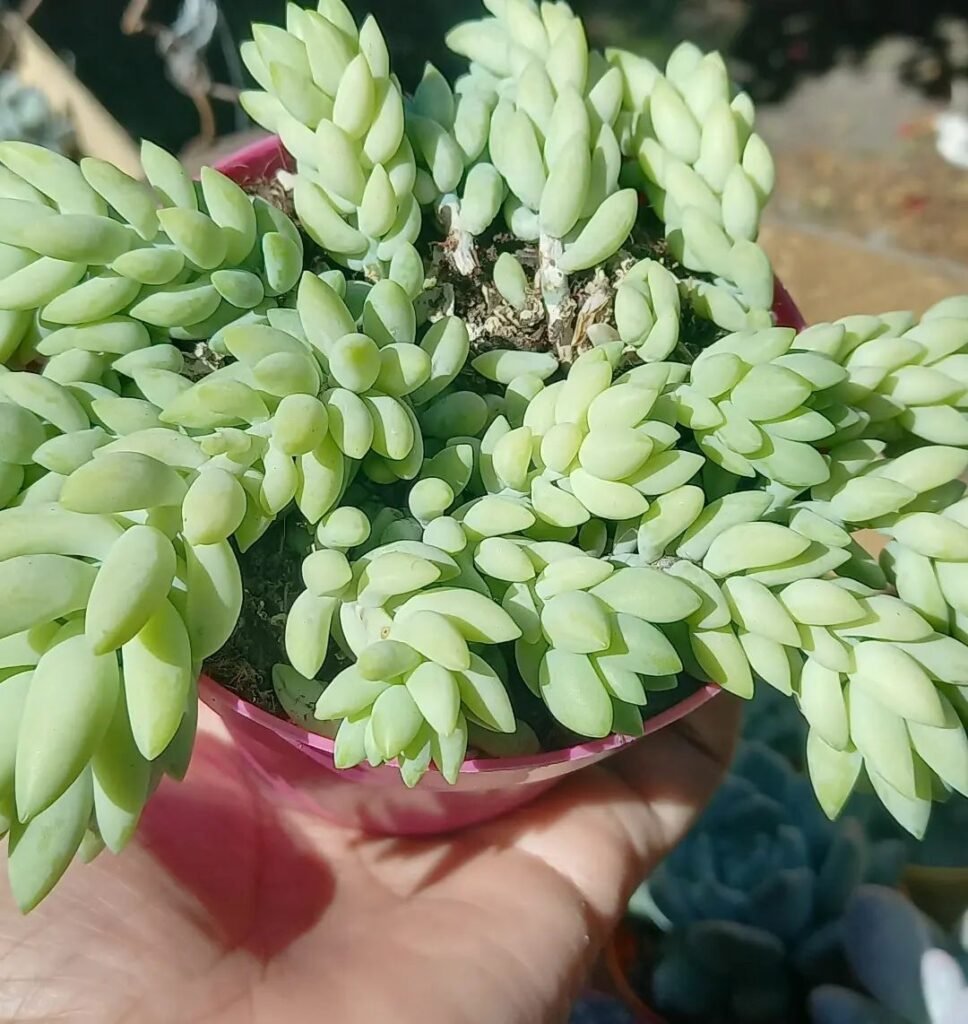

Sedum Morganianum is a relatively low-maintenance plant when it comes to fertilizing. To keep your Burro’s Tail healthy and thriving, it’s recommended to fertilize every two or three months using a “Cactus” or “Houseplant” labelled feed. These specialized feeds contain the necessary nutrients to support the growth and overall health of your Sedum Morganianum.
When it comes to the soil, using the right type is crucial for the well-being of your Burro’s Tail. Opt for a well-draining “Cactus & Succulent” potting mix to ensure adequate drainage and prevent waterlogged roots. This type of soil allows excess moisture to escape, preventing the risk of root rot and other issues that can arise from poor drainage.

Pruning and Maintenance for Burro’s Tail
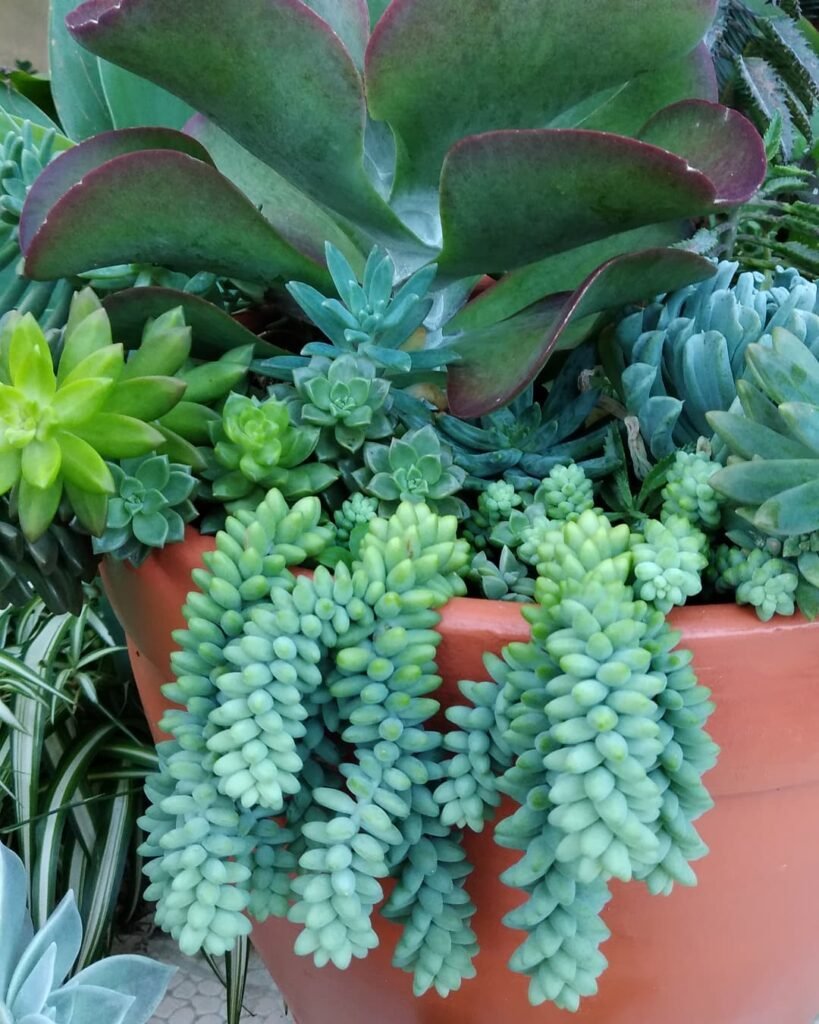
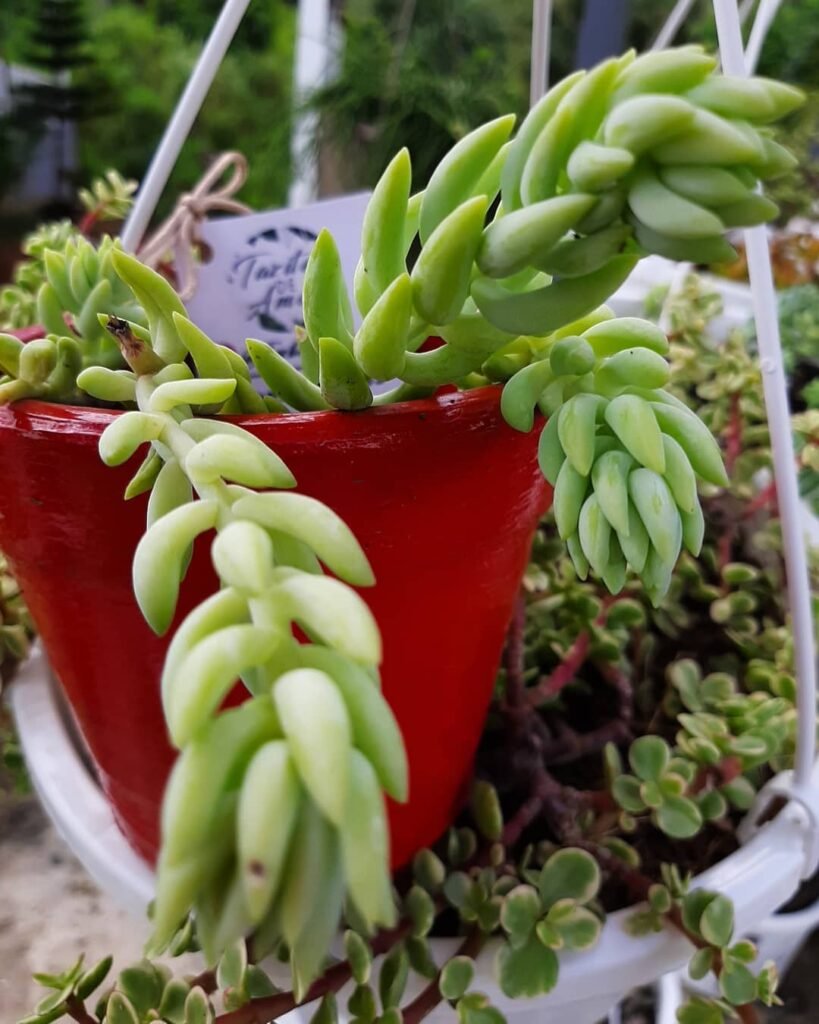
Pruning is generally not necessary for Sedum Morganianum, but it can be beneficial to remove any yellow or dying leaves. This helps promote better-growing conditions and enhances the overall appearance of the plant. When pruning, it’s essential to use clean utensils or shears to prevent the introduction of diseases or infections.
In addition to pruning, regular maintenance plays a vital role in the care of Burro’s Tail. Keep an eye on the plant and remove any debris or dust that may accumulate on the leaves. This can be done by gently wiping the leaves with a soft, damp cloth. Regular dusting not only keeps the plant looking vibrant but also improves its ability to photosynthesize.
Furthermore, it’s crucial to regularly inspect your Burro’s Tail for any signs of pests or diseases. Check the leaves, stems, and root system for any unusual spots, discolouration, or signs of pest infestation. Early detection and treatment can help prevent further damage and ensure the plant’s continued health.
To summarize, the maintenance of Sedum Morganianum involves:
- Pruning yellow or dying leaves for better-growing conditions
- Using clean utensils or shears to avoid introducing diseases or infections during pruning
- Removing debris or dust from the leaves to maintain a clean and vibrant appearance
- Regularly inspecting for signs of pests or diseases

Propagating Sedum Morganianum (Burro’s Tail)
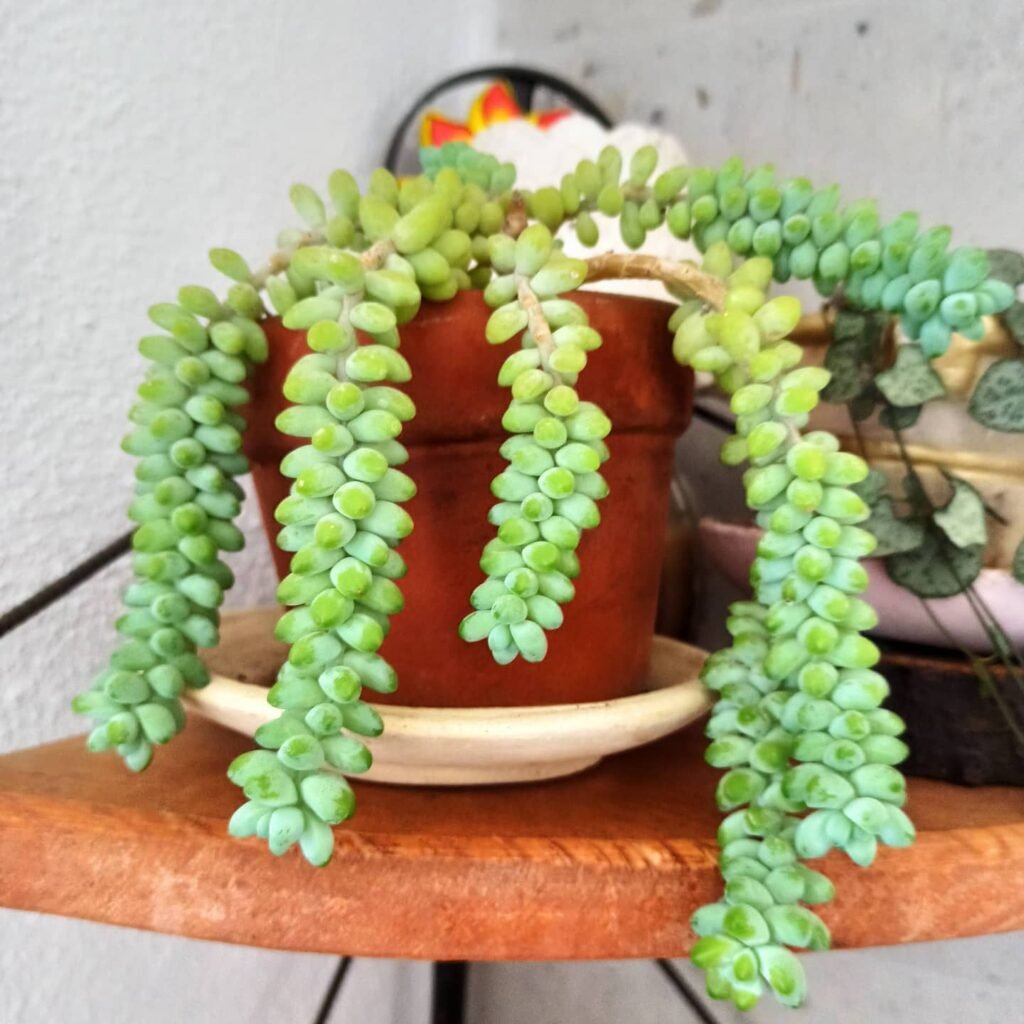

If you want to expand your collection of Sedum Morganianum or share this beautiful succulent with friends, you’ll be happy to know that it can be easily propagated through vine cuttings or leaf cuttings.ga
Vine cuttings: To propagate through vine cuttings, start by selecting healthy stems located at the vine terminals. Carefully remove the older half of the leaves, leaving the top half intact. This will ensure that the cutting can still photosynthesize and establish roots. Place the cuttings into well-draining soil and keep them in a bright, indirect setting with temperatures above 18°C. You can use a mixture of perlite and peat moss to create a suitable rooting medium.
Leaf cuttings: Another method for propagating Sedum Morganianum is through leaf cuttings. Select a healthy leaf and carefully remove it from the stem, ensuring that the wound is clean and intact. Place the leaf on top of moist cactus and succulent compost, pressing it lightly to establish contact with the soil. Keep the leaf cutting in a bright, indirect location with temperatures above 18°C. Soon, small roots will develop and new plantlets will emerge from the base of the leaf.
Both methods require patience, as it can take several weeks or even months for the cuttings to root and establish themselves. Make sure to mist the cuttings occasionally to maintain a slightly humid environment and monitor them for any signs of rot or fungal issues.

Repotting Tips for Sedum Morganianum

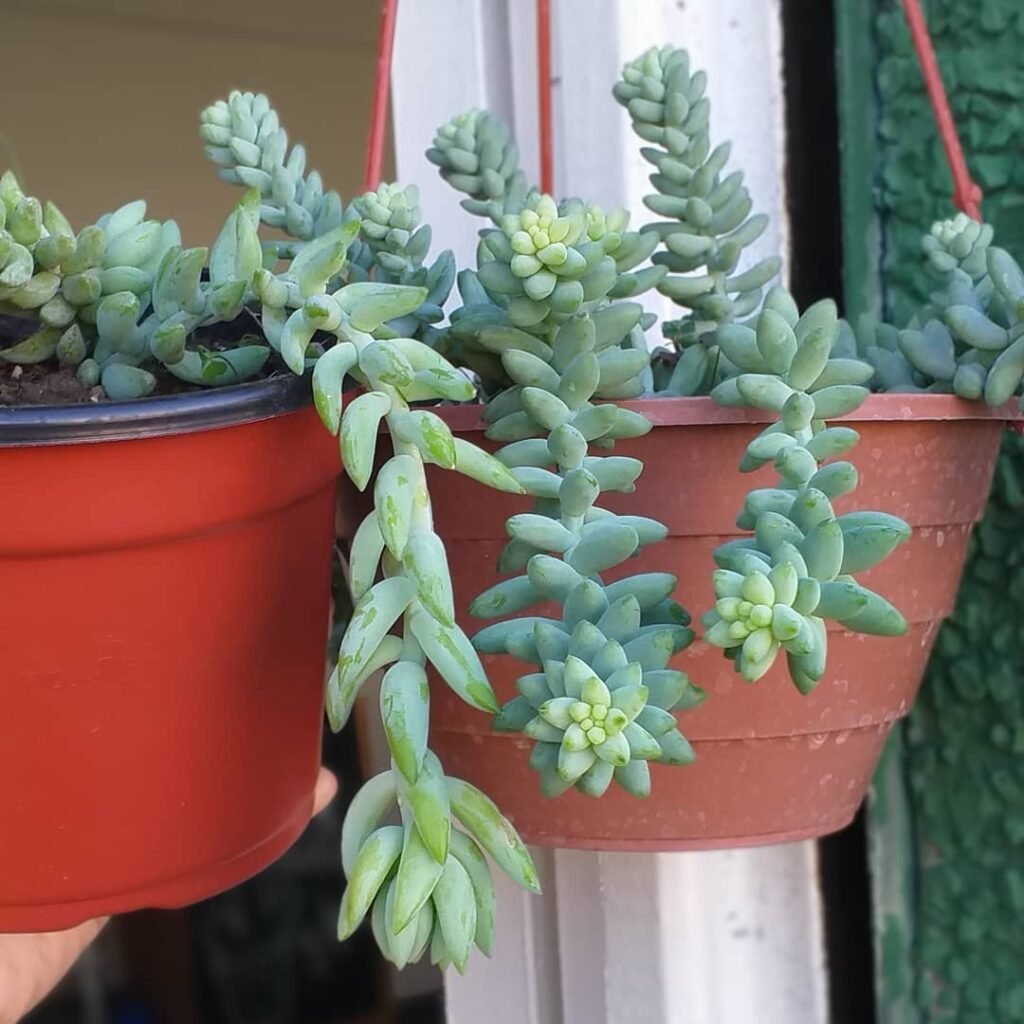
Repotting Sedum Morganianum is an essential part of caring for this beautiful succulent. It is typically done every three years during the spring season to provide the plant with fresh soil and more room for growth. Follow these repotting tips to ensure the health and vitality of your Sedum Morganianum:
- Choose the right time: Spring is the ideal time to repot Sedum Morganianum when it is entering its active growing phase.
- Select a slightly larger pot: Choose a pot that is one size up from the current pot to allow the roots to spread and promote healthy growth.
- Opt for well-draining soil: Use a well-draining “Cactus & Succulent” potting mix to ensure adequate drainage and prevent waterlogged roots. This type of soil mix provides the perfect balance of moisture retention and airflow.
- Handle with care: Sedum Morganianum has delicate leaves and stems, so be gentle when repotting to avoid any damage. Hold the plant by its base and support the stems while transferring it to the new pot.
- Prepare the new pot: Before repotting, make sure the new pot has drainage holes at the bottom to prevent water accumulation. Add a layer of gravel or small stones to further enhance drainage.
- Remove the old soil: Gently loosen the root ball and remove any excess soil from the roots. Be careful not to damage the roots during this process.
- Plant in the new pot: Place the Sedum Morganianum in the center of the new pot and fill in the gaps with the fresh potting mix. Press the soil lightly to ensure the plant is secure.
- Water sparingly: After repotting, water the plant lightly to settle the soil and help the roots establish. Avoid overwatering, as this can lead to root rot. Allow the soil to dry out between waterings.
 Sedum Morganianum has a magical touch: its leaves can start new life! These plump leaves detach easily and, if they land on soil, can root themselves to grow into new plants. This incredible self-propagation turns every fallen leaf into a potential new succulent, making it a gift that keeps on giving to any plant lover’s collection.
Sedum Morganianum has a magical touch: its leaves can start new life! These plump leaves detach easily and, if they land on soil, can root themselves to grow into new plants. This incredible self-propagation turns every fallen leaf into a potential new succulent, making it a gift that keeps on giving to any plant lover’s collection.
Common Issues and Toxicity of Burro’s Tail
When it comes to caring for Burro’s Tail (Sedum Morganianum), there are a few common issues that may arise. One of the most important things to watch out for is root rot, which can occur if the plant is overwatered. To prevent this, make sure to allow the soil to dry out completely between waterings.
Another issue you may encounter is yellowing leaves. This can be caused by excess moisture settling on the foliage, so be sure to avoid misting the leaves directly and remove any water that may accumulate in the crevices.
If you’re interested in propagating your Burro’s Tail by leaf or vine cuttings, it’s important to note that not all cuttings will take root successfully. Some may fail to root and wither away. It’s best to experiment with multiple cuttings to increase your chances of success.
It’s worth mentioning that while Burro’s Tail is a safe plant for humans and pets, it’s always a good idea to keep it out of reach of curious children and pets to prevent any accidental ingestion. By being aware of these common issues and taking proper care of your Burro’s Tail, you can enjoy its beauty for years to come.
Helpful Videos about Sedum Morganianum (Burro’s Tail)
Do take a look at these splendid videos I’ve chanced upon, centred on caring for Sedum morganianum, also known as Burro’s Tail. They’re brimming with simple guidance that eases the process of caring for this succulent. Perfect for those just starting their gardening journey. Feel free to check them out!
- How to care for Sedum Donkey’s Tail | Sedum Morganianum | Succulent Care Guide
- Burro’s Tail Propagation
FAQ about Sedum Morganianum (Burro’s Tail)

Have a look at this splendid guide I’ve put together for tending to Sedum Morganianum, also lovingly referred to as Burro’s Tail. This spot is brimming with all the tips and tricks you’ll need to help your plant thrive. From getting the watering just right to combatting the usual troubles, I’ve covered everything to make plant care straightforward for you.
Sedum Morganianum, commonly referred to as Burro’s Tail, is a succulent plant with trailing stems covered in plump, green leaves. It’s perfect for hanging baskets due to its cascading growth habit.
In the UK, Burro’s Tail is best grown indoors or in a greenhouse as it does not tolerate cold well. During summer, it can be placed outside in a protected, sunny spot.
It thrives in bright, indirect sunlight. Direct sun can scorch its leaves, while too little light may stunt growth.
Use a well-draining cactus or succulent mix. Adding perlite or sand can improve drainage, vital for preventing root rot.
Water when the top inch of soil feels dry, typically once every 1-2 weeks. Reduce watering in the winter to monthly, or whenever the soil is completely dry.
Feed with a diluted low-nitrogen, high-potassium fertiliser once in spring and again in summer to support growth and flowering.
Propagate by leaf cuttings or stem segments. Allow the cut end to callous over for a few days before planting in well-draining soil.
Leaf drop can occur from over-watering, under-watering, or simply from handling. It’s a fragile plant, so touch it as little as possible.
Inspect regularly for signs of mealybugs or aphids. Wipe them off with a damp cloth or use insecticidal soap as needed.
It prefers temperatures between 18°C and 24°C. Avoid exposing it to temperatures below 10°C.
Ensure it gets enough light and consider a cooler rest period in winter, slightly reducing water to mimic its natural habitat, which can stimulate flowering.
With the right care, its vines can grow several feet long, making a dramatic display in hanging baskets.
Sedum Morganianum is considered non-toxic to pets, but it’s best to keep it out of reach to avoid any accidental ingestion of fallen leaves.
Repot in the spring, choosing a pot only slightly larger than the current one. Handle carefully to avoid leaf drop.
If the bathroom is bright and airy, yes. The humidity can be beneficial, but ensure it gets sufficient light.
Yes, it pairs well with other succulents in a mixed container, provided all the plants have similar light and water requirements. Consider aesthetics and growth habits for a harmonious arrangement.
I hope this FAQ has made looking after your Sedum Morganianum, or Burro’s Tail, a bit clearer. If you’ve got any more questions, just drop them in the comments. I’m here to lend a hand. Gardening is a journey full of learning, and there’s always something new to uncover as your plant grows.

